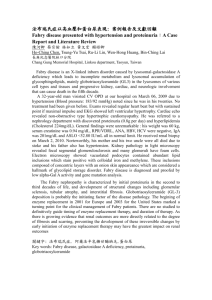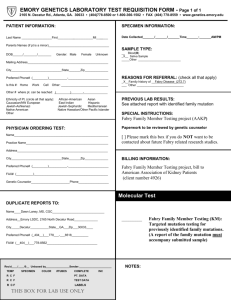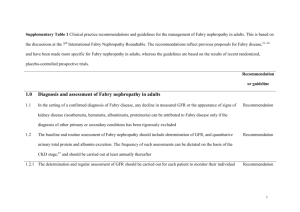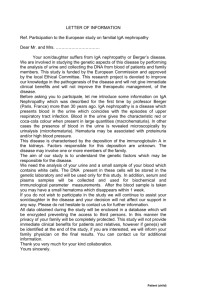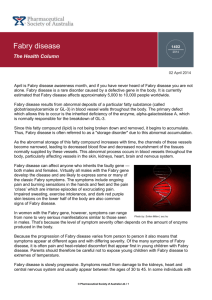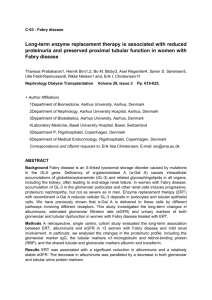What`s hiding behind IgA nephropathy?
advertisement
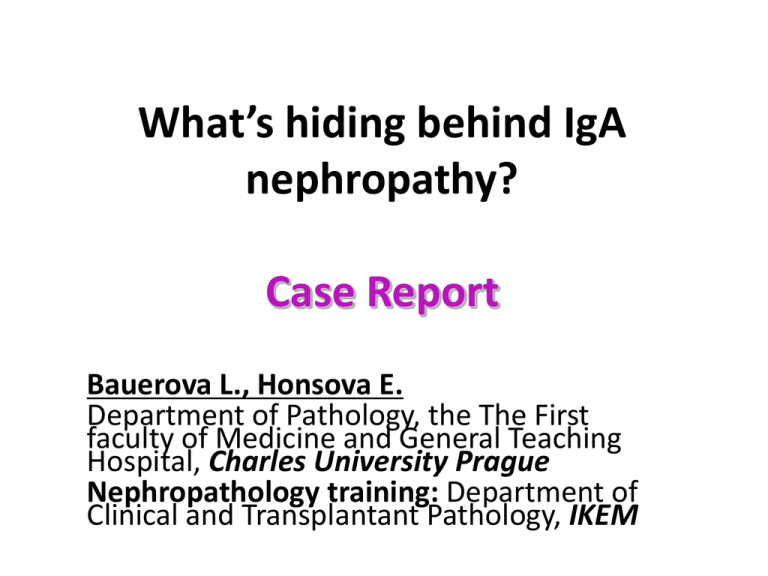
What’s hiding behind IgA nephropathy? Case Report Bauerova L., Honsova E. Department of Pathology, the The First faculty of Medicine and General Teaching Hospital, Charles University Prague Nephropathology training: Department of Clinical and Transplantant Pathology, IKEM Clinical history: • • • • • 31– year – old woman Proteinuria, fatigue, edema of the hands Tinnitus and sudden hearing loss of the left ear Arterial hypertension Nephrotic proteinuria (5g/day) and microscopic hematuria • Serum creatinine level of 73μmol/l (0,79mg/dl) • Audiometry → hearing abnormalities • Immunology was negative (ELISA testing – IgA, IgM, IgG, C3 and C4 complement, extractable nuclear antigen (ENA), antinuclear antibodies (ANA), ds-DNA antibodies, ANCA, rheuma factor). IgA Diagnosis: IgA nephropathy + suspicious Fabry´s disease ↓ Genetic testing was recommended ↓ (Low -galactosidase A activity in plasma and leucocytes) + Heterozygous mutation of α-Gal A gene Aberrantly glycosylated IgA1 IgA nephropathy Complement components Production of antiglycan antibodies IgG-IgA1, IgA1-IgA1 complexes • Proliferation of mesangial cells • Expansion of ECM • Cytokines and growth factors production • Local complement activation Fibronectin Type IV collagen Podocytes and tubular cells damage Fabry´s disease • • • • X-linked recessive lysosomal storage disorder Deficient activity of α-galactosidase A Clinical manifestations are variable Skin lesions, corneal dystrophy, paresthesias and proteinuria • During adulthood: heart disease, premature cerebrovascular accidents, and progressive renal disease Fabry´s disease • The link between the metabolic abnormality in Fabry´s disease and kidney tissue injury is still unclear • In females, there are highly variable levels of enzyme activity and broader range of clinical symptoms • Most females are affected; in various studies, 12% of Fabry´s patients on dialysis are women In a kidney biopsy sample • Swollen, finely vacuolated podocytes in LM • Dark blue bodies in semi-thin sections embedded in epoxy resin • Osmiophilic, lamellar bodies mainly in podocytes (myelin figures, “zebra” bodies) in ELMI • All renal cells can be affected • Difficulties in cases with more advanced stages of FD A case for second opinion Differential diagnosis • Myelin-like inclusions are not entirely specific for Fabry´s disease • Long-term treatment with cationic amphiphilic drugs (chloroquine and amiodarone) • Chloroquine-induced lipidosis in the kidney is not so rare • Specific curvilinear inclusions in podocytes are not present in FD (Prof. Ferluga in his lecture, 23rd ECP, Helsinki 2011) Dusan Ferluga: Electron microscopy of Fabry nephropathy and drug-induced phospholipidosis. 23rd ECP, Helsinki 2011 The coexistence of IgA nephropathy and Fabry´s disease: • The coexistence of FD and immune disorders such as SLE, rheumatoid arthritis and pauciimmune and immune complex-mediated necrotizing crescentic glomerulonephritis has been described in the literature • The combination of FD and IgAN is rare Patient´s follow up: • Human α-galactosidase A replacement therapy • Antihypertensive drugs with diuretics • Cardiac function and blood pressure in the normal range • S-Cr: 65 μmol/l (0.71 mg/dl) • Proteinuria decreased (1g/day) • Peripheral edema disappeared • Still suffering from: fatigue, paresthesia, tinnitus, and hearing loss Thank You
